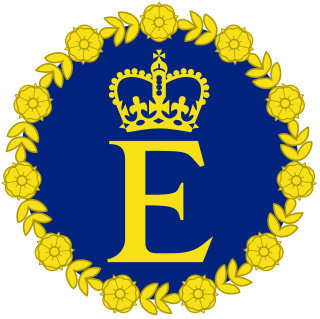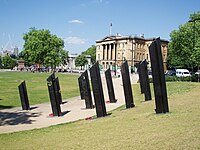
Hyde Park is a 350 acres (140 ha), historic Grade I-listed urban park in Westminster, Greater London. A Royal Park, it is the largest of the parks and green spaces that form a chain from Kensington Palace through Kensington Gardens and Hyde Park, via Hyde Park Corner and Green Park, past Buckingham Palace to St James's Park. Hyde Park is divided by the Serpentine and the Long Water lakes.

Hyde Park, Sydney, is an urban park, of 16.2-hectare (40-acre), located in the central business district of Sydney, in the City of Sydney local government area of New South Wales, Australia. It is the oldest public parkland in Australia. Hyde Park is on the eastern fringe of the Sydney city centre and is approximately rectangular in shape, being squared at the southern end and rounded at the northern end. It is bordered on the west by Elizabeth Street, on the east by College Street, on the north by St James Road and Prince Albert Road and on the south by Liverpool Street.

The Albert Memorial, directly north of the Royal Albert Hall in Kensington Gardens, London, was commissioned by Queen Victoria in memory of her beloved husband Prince Albert, who died in 1861. Designed by Sir George Gilbert Scott in the Gothic Revival style, it takes the form of an ornate canopy or pavilion 176 feet (54 m) tall, in the style of a Gothic ciborium over the high altar of a church, sheltering a statue of the prince facing south. It took over ten years to complete, the £120,000 cost met by public subscription.

Kensington Gardens, once the private gardens of Kensington Palace, are among the Royal Parks of London. The gardens are shared by the City of Westminster and the Royal Borough of Kensington and Chelsea and sit immediately to the west of Hyde Park, in western central London known as the West End. The gardens cover an area of 107 hectares. The open spaces of Kensington Gardens, Hyde Park, Green Park, and St. James's Park together form an almost continuous "green lung" in the heart of London. Kensington Gardens are Grade I listed on the Register of Historic Parks and Gardens.

The flag of New Zealand, also known as the New Zealand Ensign, is based on the British maritime Blue Ensign – a blue field with the Union Jack in the canton or upper hoist corner – augmented or defaced with four red stars centred within four white stars, representing the Southern Cross constellation.

Haka are a variety of ceremonial dances in Māori culture. A performance art, haka are often performed by a group, with vigorous movements and stamping of the feet with rhythmically shouted accompaniment. Haka have been traditionally performed by both men and women for a variety of social functions within Māori culture. They are performed to welcome distinguished guests, or to acknowledge great achievements, occasions, or funerals.

Hyde Park Corner is between Knightsbridge, Belgravia and Mayfair in London, England. It primarily refers to a major road junction at the southeastern corner of Hyde Park, that was originally planned by architect Decimus Burton. The junction includes a broad green-space roundabout in its centre, which is now the setting for Burton's triumphal Wellington Arch.

The Royal Artillery Memorial is a First World War memorial located on Hyde Park Corner in London, England. Designed by Charles Sargeant Jagger, with architectural work by Lionel Pearson, and unveiled in 1925, the memorial commemorates the 49,076 soldiers from the Royal Artillery killed in the First World War. The static nature of the conflict, particularly on the Western Front, meant that artillery played a major role in the war, though physical reminders of the fighting were often avoided in the years after the war. The Royal Artillery War Commemoration Fund (RAWCF) was formed in 1918 to preside over the regiment's commemorations, aware of some dissatisfaction with memorials to previous wars. The RAWCF approached several eminent architects but its insistence on a visual representation of artillery meant that none was able to produce a satisfactory design. Thus they approached Jagger, himself an ex-soldier who had been wounded in the war. Jagger produced a design which was accepted in 1922, though he modified it several times before construction.

Sir Ian Hugh Kāwharu was an academic and paramount chief of the Ngāti Whātua Māori tribe in New Zealand.

London Buses route 9 is a Transport for London contracted bus route in London, England. Running between Hammersmith bus station and Aldwych, it is operated by Metroline.
Haka, traditional dances of the Māori people, have been used in sports in New Zealand and overseas. Haka are performed to challenge opponents before matches. The dance form has been adopted by the New Zealand national rugby union team, the "All Blacks", the Māori All Blacks, New Zealand women's national rugby union team, the "Black Ferns" and a number of other New Zealand national teams perform before their international matches; some non-New Zealand sports teams have also adopted haka.

Queen Elizabeth II had a variety of flags to represent her personally and as head of state of several independent nations around the world. They were usually used on any building, ship, car, or aircraft where she was present.

The Australian War Memorial in London is a memorial dedicated in 2003 to the 102,000 Australian dead of the First and Second World Wars. It is located on the southernmost corner of Hyde Park Corner, on the traffic island that also houses the Wellington Arch, the New Zealand War Memorial, the Machine Gun Corps Memorial and the Royal Artillery Memorial.

The Royal Air Force Bomber Command Memorial is a memorial in Green Park, London, commemorating the crews of RAF Bomber Command who embarked on missions during the Second World War. The memorial, on the south side of Piccadilly, facing Hyde Park Corner, was built to mark the sacrifice of 55,573 aircrew from Britain, Canada, Australia, New Zealand, Poland, Czechoslovakia and other allied countries, as well as civilians of all nations killed during raids.

The 7 July Memorial is a permanent memorial to the 52 victims of the 7 July 2005 London bombings. It is located on the east side of Hyde Park, between Lover's Walk and Park Lane, close to Curzon Gate and about 150 metres (490 ft) north of the monumental statue of Achilles.

The New Zealand shilling was first issued in 1933 alongside four other denominations of New Zealand pound coinage, introduced due to shortages of comparable British silver coinage following the devaluation of the New Zealand pound relative to the pound sterling. Roughly 24 mm in diameter, it is slightly larger than the British coin it replaced. Worth twelve pence, the denomination was equal to half a florin, two sixpence, or two-fifths of a half-crown.

















